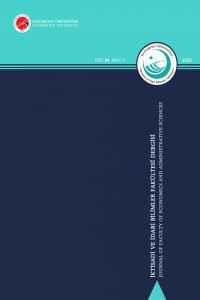STOCK MARKET AS AN INDICATOR OF MARITIME TRANSPORT DEMAND: AN EVIDENCE FROM TURKEY AND ISTFIX REGION
Asymmetric causality, ISTFIX, Stock exchange, Freight market
___
- Adaramola, A. O. (2011). The Impact of Macroeconomic Indicators on Stock Prices in Nigeria. Developing Country Studies, 1(2), 1-14.
- Ake, B. (2010). The Role of Stock Market Development in Economic Growth: Evidence from Some Euronext Countries. International Journal of Financial Research, 1(1),14-20.
- Ali, I., Rehman, K. U., Yilmaz, A. K., Khan, M. A., & Afzal, H. (2010). Causal Relationship Between Macro-Economic Indicators and Stock Exchange Prices in Pakistan. African Journal of Business Management, 4(3), 312-319.
- Aylward, A., & Glen, J. (2000). Some International Evidence on Stock Prices as Leading Indicators of Economic Activity. Applied Financial Economics, 10(1), 1-14.
- Bildirici, M. E., & Turkmen, C. (2015). Nonlinear Causality Between Oil and Precious Metals. Resources Policy, 46, 202-211.
- Bornozis, N. (2006). Dry Bulk Shipping: The Engine of Global Trade. White Paper.
- Chaudhuri, K., & Smiles, S. (2004). Stock Market and Aggregate Economic Activity: Evidence from Australia. Applied Financial Economics, 14(2), 121-129.
- Chistè, C., & Van Vuuren, G. (2014). Investigating The Cyclical Behavior of the Dry Bulk Shipping Market. Maritime Policy & Management, 41(1), 1-19.
- Chou, M. T., Su, Y. L., Chou, T. Y., & Liang, H. U. (2015). An Analysis of the Relationship between Asian Steel Index and the Baltic Capsize Index. Modern Economy, 6(02), 207-216.
- Dai, L., Hu, H., Chen, F., & Zheng, J. (2015). The Dynamics Between Newbuilding Ship Price Volatility and Freight Volatility in Dry Bulk Shipping Market. International Journal of Shipping and Transport Logistics, 7(4), 393-406.
- Dura, Y. C., Beser, M. K., & Acaroglu, H. (2017). Türkiye'nin Ihracata Dayali Büyümesinin Ekonometrik Analizi. Ege Akademik Bakis, 17(2), 295.
- Enisan, A. A., & Olufisayo, A. O. (2009). Stock Market Development and Economic Growth: Evidence from Seven Sub-Sahara African Countries. Journal of Economics and Business, 61(2), 162-171.
- Granger, C. W. (1969). Investigating Causal Relations by Econometric Models and Cross-Spectral Methods. Econometrica: Journal of the Econometric Society, 424-438.Hatemi-j, A. (2012). Asymmetric Causality Tests with an Application. Empirical Economics, 43(1), 447-456.
- Hatemi-J, A., & Uddin, G. S. (2012). Is The Causal Nexus of Energy Utilization and Economic Growth Asymmetric in the US?. Economic Systems, 36(3), 461-469.
- Hussainey, K., & Khanh Ngoc, L. (2009). The Impact of Macroeconomic Indicators on Vietnamese Stock Prices. The Journal of Risk Finance, 10(4), 321-332.
- Investing (2018). Stock Market Indices, https://tr.investing.com/, Accessed on: 20.08.2018.
- ISTFIX (2018). Istanbul Freight Index, http://www.istfix.com/.
- Karamperidis, S., Jackson, E., & Mangan, J. (2013). The Use of Indices in the Maritime Transport Sector. Maritime Policy & Management, 40(4), 339-350.
- Köseoğlu, S. D., & Mercangöz, B. A. (2012). 2008 Küresel Finansal Krizinin Küçük Tonaj Gelirleri Üzerindeki Etkisinin Yapısal Kırılma Testi ile Araştırılması. Dokuz Eylül Üniversitesi Denizcilik Fakültesi Dergisi, 4(1).
- Kwon, C. S., & Shin, T. S. (1999). Cointegration and Causality between Macroeconomic Variables and Stock Market Returns. Global Finance Journal, 10(1), 71-81.
- Lee, M., & Gan, C. (2006). Macroeconomic Variables and Stock Market Interactions: New Zealand Evidence. Investment Management and Financial Innovations, 3, 4.
- Lun, Y. V., & Quaddus, M. A. (2008). An empirical Model of the Bulk Shipping Market. International Journal of Shipping and Transport Logistics, 1(1), 37-54.
- Maysami, R. C., Howe, L. C., & Rahmat, M. A. (2005). Relationship between Macroeconomic Variables and Stock Market Indices: Cointegration Evidence from Stock Exchange of Singapore's All-S Sector Indices. Jurnal Pengurusan (UKM Journal of Management), 24.
- McMillan, D. (2005). Time variation in The Cointegrating Relationship between Stock Prices and Economic Activity. International Review of Applied Economics, 19 ,359-68.
- Mukherjee T.K. and A. Naka (1995). Dynamic Relations between Macroeconomic Variables and the Japanese Stock Market. An application of Vector Error Correction Model. Journal of Finance Research, 18, 223-237.
- Nishat M & Saghir M (1991). The Stock Market and Pakistan Economy, Savings and Development, 15(2): 131-145.
- Olweny, T. O., & Kimani, D. (2011). Stock Market Performance and Economic Growth Empirical Evidence from Kenya using Causality Test Approach. Advances in Management and Applied Economics, 1(3), 177.
- Stopford, M. (2009). Maritime Economics 3.ed. Routledge, London
- Toda, H.Y., Yamamoto, T., 1995. Statistical Inference in Vector Autoregressions with Possibly Integrated Processes. Journal of Econometrics, 66, 225–250.
- Tugcu, C. T., Ozturk, I., & Aslan, A. (2012). Renewable and Non-Renewable Energy Consumption and Economic Growth Relationship Revisited: Evidence from G7 Countries. Energy economics, 34(6), 1942-1950.
- Umar, M., & Dahalan, J. (2016). An Application of Asymmetric Toda-Yamamoto Causality on Exchange Rate-Inflation Differentials in Emerging Economies. International Journal of Economics and Financial Issues, 6(2), 420-426.
- Ünal, G., & Derindere Köseoğlu, S. (2014). Revealing The Freight Market Risk in Istfix Shipping Area. International Journal of Shipping and Transport Logistics, 6(6), 593-610.
- Yayın Aralığı: Yılda 2 Sayı
- Başlangıç: 2013
- Yayıncı: Kastamonu Üniversitesi
TEKNOLOJİK RİSK YÖNETİMİNDE İNTERNET BANKACILIĞININ FIRSAT VE TEHDİTLERİ
Bülent GÜNCELER, Murat KESEBİR
DO TECHNOLOGY TRIGGER UNEMPLOYMENT AND UNHAPPINESS?
Türkay DERELİ, Cihan ÇETİNKAYA, Nazmiye ÇELİK
KÜMELENMENİN ANLAMI: AKADEMİK BAKIŞ AÇILARININ ÇÖZÜMLENMESİ ÜZERİNE BİR DENEME
Mustafa Atilla ARICIOĞLU, Büşra YİĞİTOL, Aylin YILMAZ
SWOT AND SOR ANALYZES OF VEGETABLE SEEDS SECTOR İN ANTALYA PROVINCE OF TURKEY
STOCK MARKET AS AN INDICATOR OF MARITIME TRANSPORT DEMAND: AN EVIDENCE FROM TURKEY AND ISTFIX REGION
Sadık Özlen BAŞER, Abdullah AÇIK
FİNANSAL YENİLİKLERİN GELİŞİMİ VE TÜRK BANKACILIK SEKTÖRÜNE ETKİLERİ
MALİ BAŞARISIZLIKTA MALİYET KÖRLÜĞÜ ETKİSİNİN İŞLEM MALİYETİ YAKLAŞIMI İLE DEĞERLENDİRİLMESİ
DIŞ TİCARET İŞLEMLERİNDE TERCİH EDİLEN ÖDEME YÖNTEMLERİ: DOĞU KARADENİZ BÖLGESİ ÜZERİNE BİR UYGULAMA
Afife ÖZTÜRK, Ali Rıza SANDALCILAR
TÜRKİYE’DE GELİR DAĞILIMI VE EKONOMİK BÜYÜME ARASINDAKİ İLİŞKİ: ARDL SINIR TESTİ YAKLAŞIMI
